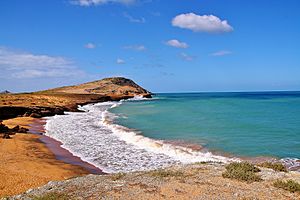Cabo de la Vela facts for kids
Cabo de la Vela (which means "cape of sail" in Spanish) is a special place in Colombia. It's a headland, which is a piece of land that sticks out into the sea. You can find it on the Guajira Peninsula. Next to it is a small fishing village. This area is very popular for ecotourism, which means visiting nature in a way that protects it. It's a beautiful spot in the Caribbean region of Colombia.
Contents
History of Cabo de la Vela
First European Visitors
The first Europeans to see Cabo de la Vela arrived in 1499. They were led by a Spanish explorer named Juan de la Cosa. He was a pilot on an expedition with Alonso de Ojeda. This made Cabo de la Vela one of the very first places in South America visited by Europeans.
The name "Cabo de la Vela" comes from how it looked to the Spanish explorers. When they saw the pale colors and curved shapes of the land from the sea, it reminded them of a sailboat.
Early Settlements and Challenges
In 1535, a person named Nikolaus Federmann started the first European village near Cabo de la Vela. He named it Nuestra Señora Santa María de los Remedios del Cabo de la Vela. This was the first settlement in the La Guajira area.
People found many valuable pearls here. But because of these pearls, the village was often attacked. The local Wayuu people and other Spanish explorers from nearby areas tried to take control. Because of these constant attacks, the village had to move. In 1544, it was moved to where Riohacha is today, and Nikolaus Federmann helped rebuild it there.
The Wayuu People's Sacred Land
The original people living in this area were an ethnic group called Arawaks. They managed to stay free and were not conquered by the Spanish. Their descendants, the Wayuu people, still live in the area today.
Cabo de la Vela is a very sacred place for the Wayuu people. In their language, Wayuunaiki, they call it Jepirra. They believe it is the place where the souls of all people who have passed away travel. It's like a gate to the afterlife, where their souls can rest with their ancestors.
Nature and Climate
Description of the Area
Cabo de la Vela is surrounded by the La Guajira Desert. This desert is part of a larger dry area called the Guajira-Barranquilla xeric scrub.
In this area, you can find several salty lagoons and flat, muddy areas called mudflats. Many American flamingos visit these places. They are beautiful birds with bright pink feathers.
Climate of Cabo de la Vela
Cabo de la Vela has a hot arid climate. This means it is very hot and dry. There is very little rain for most of the year. The only months that get some rainfall are October and November.
| Climate data for Cabo de la Vela | |||||||||||||
|---|---|---|---|---|---|---|---|---|---|---|---|---|---|
| Month | Jan | Feb | Mar | Apr | May | Jun | Jul | Aug | Sep | Oct | Nov | Dec | Year |
| Mean daily maximum °C (°F) | 31.7 (89.1) |
32.0 (89.6) |
32.4 (90.3) |
33.0 (91.4) |
33.8 (92.8) |
34.3 (93.7) |
34.9 (94.8) |
34.5 (94.1) |
34.2 (93.6) |
33.2 (91.8) |
32.5 (90.5) |
32.2 (90.0) |
33.2 (91.8) |
| Daily mean °C (°F) | 27.5 (81.5) |
27.7 (81.9) |
28.1 (82.6) |
28.7 (83.7) |
29.5 (85.1) |
30.0 (86.0) |
30.2 (86.4) |
30.0 (86.0) |
29.8 (85.6) |
29.0 (84.2) |
28.5 (83.3) |
28.0 (82.4) |
28.9 (84.1) |
| Mean daily minimum °C (°F) | 23.3 (73.9) |
23.5 (74.3) |
23.8 (74.8) |
24.4 (75.9) |
25.2 (77.4) |
25.7 (78.3) |
25.5 (77.9) |
25.6 (78.1) |
25.4 (77.7) |
24.9 (76.8) |
24.5 (76.1) |
23.8 (74.8) |
24.6 (76.3) |
| Average rainfall mm (inches) | 2 (0.1) |
1 (0.0) |
0 (0) |
25 (1.0) |
24 (0.9) |
11 (0.4) |
2 (0.1) |
15 (0.6) |
46 (1.8) |
101 (4.0) |
82 (3.2) |
19 (0.7) |
328 (12.8) |
| Source: Climate-Data.org | |||||||||||||
See also
 In Spanish: Cabo de la Vela para niños
In Spanish: Cabo de la Vela para niños


